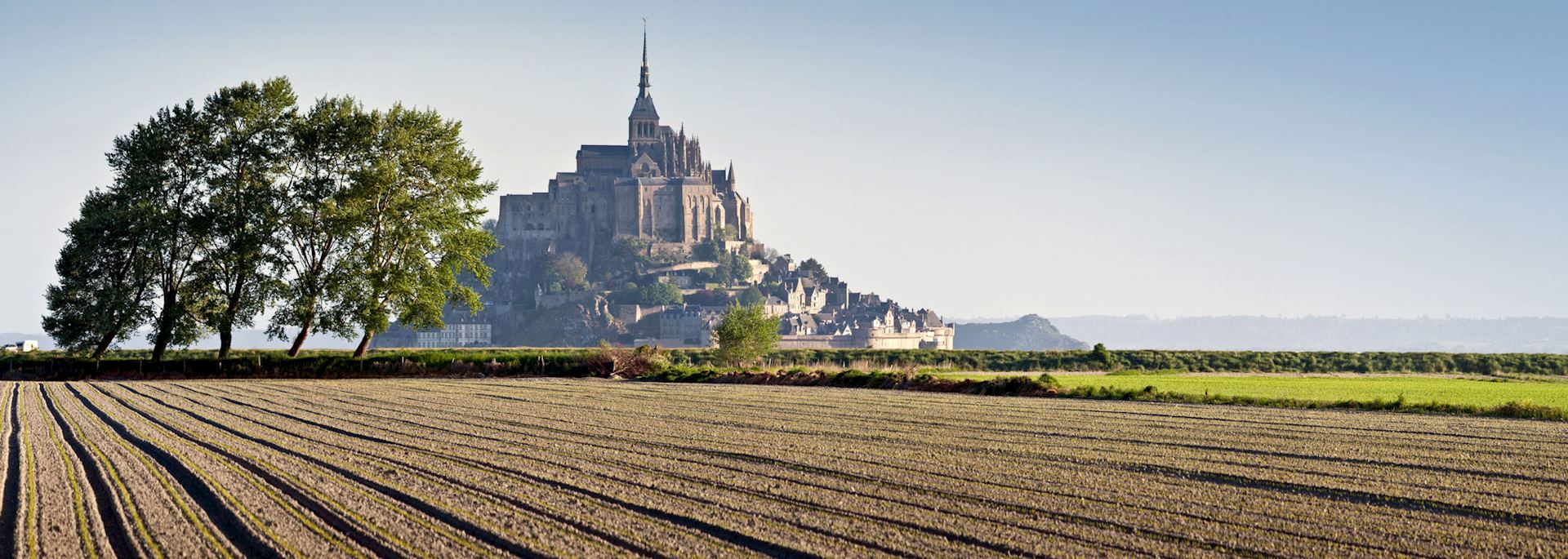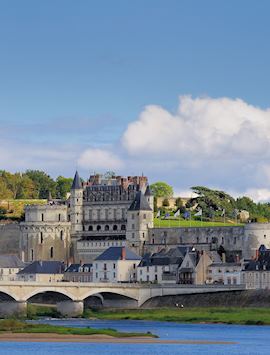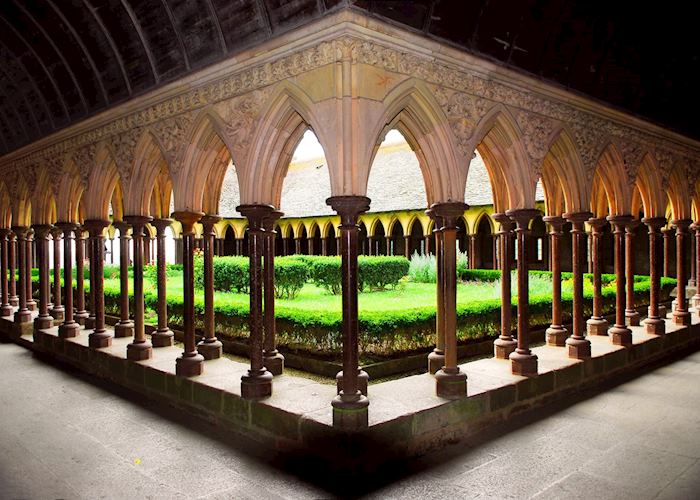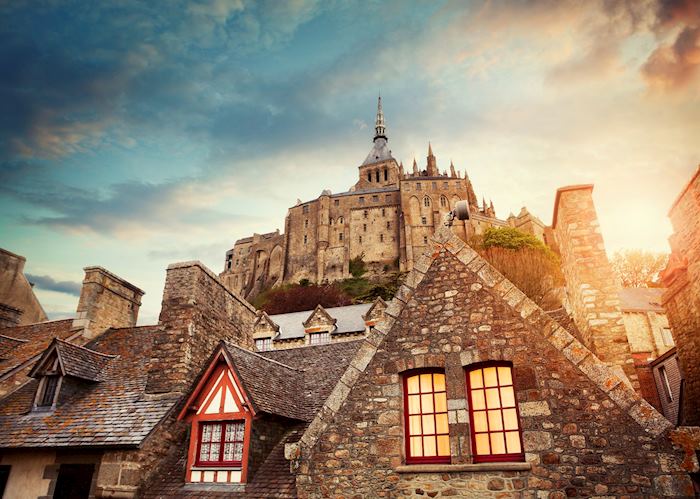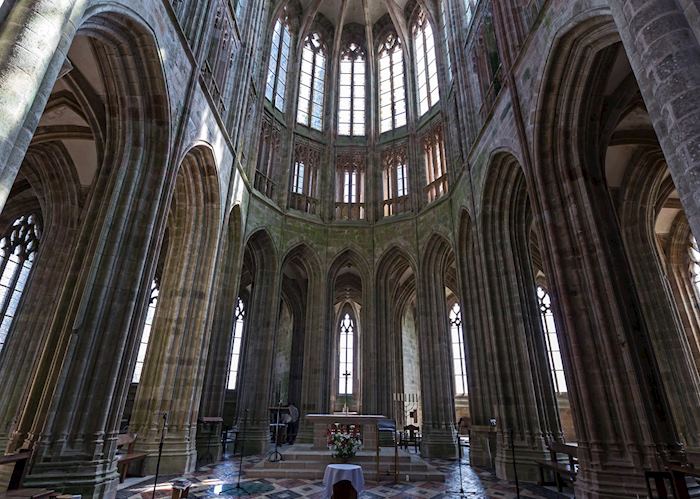Jump to:
Mont Saint-Michel is a medieval monastery set on top of a craggy outcrop, forming a self-contained tidal island roughly 1 km (0.6 miles) off the northwest Norman coast. It's been a place of pilgrimage since the 8th century, and even today, its location alone is arresting: a patchwork of Gothic buildings and turreted ramparts rises up above a flat expanse of salt meadows and grazing sheep; it’s reminiscent of some sort of Tolkienesque citadel. In fact, Peter Jackson used it as the model for Minas Tirith in his Lord of the Rings trilogy.
It’s connected to the mainland by a bridge, and surrounded at low tide by sand flats that would quickly turn treacherous for crossing pilgrims: when the waters return, they do so with terrifying speed, rushing in as fast as a galloping horse. Today, however, crossing and tide times are well-monitored.
A UNESCO World Heritage Site, Mont Saint-Michel is an extremely popular spot, but our specialists can advise you on how to get the most out of your visit. They’ll time your arrival for quieter parts of the day and direct you to less well-known corners of the site that reveal its authentic, old-world feel.
France specialist JesseFor me, there’s something almost otherworldly about visiting Mont-Saint-Michel, particularly if I’m admiring the view from the terrace and the monks begin to sing. If I can, I time my trip to watch the tide come rushing in over the salt meadows.
Things to see and do in Mont Saint-Michel
Mont Saint-Michel’s history
The first chapel was built on the rock in 708 after the local bishop had a heavenly vision of the Archangel Michael (a gilded statue of the warrior angel tops the tallest spire). It quickly became a place of pilgrimage and when the Benedictine order were given the site in the 10th century, they immediately began work on the abbey. Increased religious and political tension was spreading across Europe, however, and a military garrison was later established below the monastery.
It proved its worth in the Hundred Years War: Mont Saint-Michel remained the only place in France not to fall into the hands of the English. After the French Revolution the monastery was closed and the mount was turned into a prison. Today a small community of nuns and monks from the Monastic Fraternity of Jerusalem live and worship here.
The lower mount
The mount is reached by a curving bridge that leads across from the mainland and you can choose to arrive on foot, by shuttle bus or horse-drawn carriage. There's only one entrance in the robust rampart walls which leads to the main street, or Grande Rue.
From here, tiny medieval streets fan out, leading you away from the plethora of souvenir shops and cafés, and up stone stairs and passageways to tranquil residential streets, a little parish church and the small cemetery.
The mount was arranged in the style of a typical feudal community in accordance with the Great Chain of Being: the abbey at the top, halls and housing in the middle, and at the bottom, outside the protective walls, the cottages of poor fishermen.
The abbey
Right at the summit of the mount is the abbey, a jumble of architectural styles that reflects its development over the centuries. Like the mount, it’s built on several levels with the abbot's apartments and guest rooms at the top, the monks, church and cloister in the middle and the pilgrims received on the lower levels.
The abbey church is a medley of Norman and Gothic architecture, the nave and south transept built in a sturdy, simple style while the choir is more elaborate and displays flamboyant Gothic detailing. Mass is held here every day except Monday. From mid-July to the end of August you can visit at night, when the abbey is illuminated and chamber music plays.
La Merveille
The multi-tiered buildings clinging to the northern side of the mount are known as La Merveille (The Marvel). Most celebrated is the 13th-century cloister with its double row of dexterously carved arches and sheltered garden. Here too is the enormous refectory hall with its recessed windows framed by a colonnade of arches, the guest hall with its cavernous fireplaces and the Knight's Hall with its elegant rib vaulting.
The Underground Chapel of Our Lady is one of the oldest parts of the abbey, dating from the late 10th century. Once you have had a look around, walk back along the ramparts from the Tour du Nord for sweeping views out over the bay.
who's been there

Start planning your tailor-made trip to Mont Saint-Michel by contacting one of our France specialists
-
617-223-4521617-223-4762
- Make an inquiry
Suggested itinerary featuring Mont Saint-Michel
This sample itinerary will give you an idea of what is possible when you travel in Mont Saint-Michel, and showcases routes we know work particularly well. Treat this as inspiration, because your trip will be created uniquely by one of our specialists.
Places near Mont Saint-Michel
- Bayeux 59 miles away
- Normandy 80 miles away
- Honfleur 97 miles away
- Chinon 130 miles away
- Château de Villandry 130 miles away
- Rouen 132 miles away
- Château d'Azay-le-Rideau 133 miles away
- The Loire Valley 139 miles away
- Amboise 144 miles away
- Château de Chaumont-sur-Loire 149 miles away
- Château de Chenonceau 151 miles away
- Château de Chambord 157 miles away
- Château de Cheverny 159 miles away
- Paris 177 miles away
- Arras 225 miles away
- Lille 248 miles away
- Reims 257 miles away
- Bordeaux 266 miles away
- Saint-Émilion 267 miles away
- Sarlat-la-Canéda 290 miles away
- Beynac-et-Cazenac 291 miles away
- Castelnaud-la-Chapelle 293 miles away
- La Roque-Gageac 293 miles away
- Dordogne 295 miles away
Photos of Mont Saint-Michel
Our expert guides to exploring Mont Saint-Michel
Written by our specialists from their own experiences of visiting Mont Saint-Michel, these guides will help you make the most of your time there. We share both our practical recommendations and the best ways to appreciate Mont Saint-Michel at its best.
-
Introducing Normandy: from the D-Day Beaches to the Bayeux Tapestry ![American Cemetery, Normandy]()
Introducing Normandy: from the D-Day Beaches to the Bayeux Tapestry
Introducing Normandy: from the D-Day Beaches to the Bayeux Tapestry
A land of apples and honey (and invasions), Normandy has a long and complicated history. Discover the region’s medieval roots at Bayeux, visit the shores that inspired Impressionism at Honfleur, and pay your respects at the D-Day beaches.
Read this guide
Ideas for experiencing Mont Saint-Michel
Our specialists seek out authentic ways to get to know the places that could feature in your trip. These activities reflect some of the experiences they've most enjoyed while visiting Mont Saint-Michel, and which use the best local guides.
-
Mont Saint-Michel and seaside lunch ![Mont Saint-Michel, Normandy]()
Mont Saint-Michel and seaside lunch
Mont Saint-Michel and seaside lunch
Discover the medieval monastery and village set on a rocky outcrop in the sea. Tour the Romanesque and Gothic buildings with a guide before enjoying lunch overlooking the sea in a nearby town.
View details
